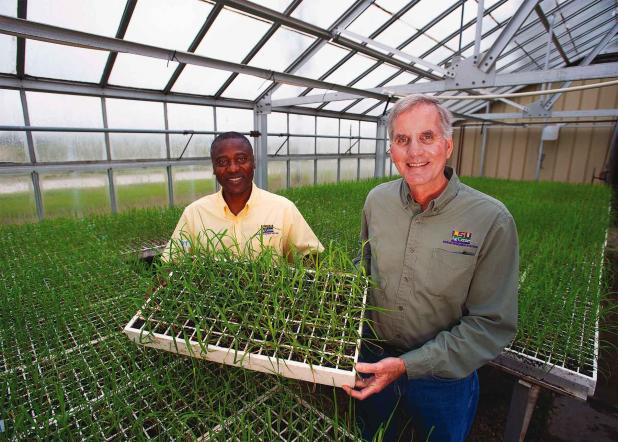
LSU AgCenter sugar cane breeder Collins Kimbeng, left, and sugar cane specialist Kenneth Gravois hold a tray of sugar cane seedlings at the AgCenter Sugar Research Station in St. Gabriel on April 12.
LSU AgCenter/Olivia McClure
New cane varieties are key to success
\In parishes across south Louisiana, fall signals the start of “grinding season” — the time when farmers harvest their sugar cane crop and carry it to one of 11 mills where it is processed into raw sugar and molasses.
Most of the cane that makes it way to these mills are varieties developed by LSU AgCenter researchers.
Sugar cane variety evaluation in Louisiana dates back to 1885.
“A sugar research station was here before the Hatch Act,” said Kenneth Gravois, LSU AgCenter sugarcane specialist, referring to the Hatch Act of 1887, which authorized the establishment of agricultural experiment stations affiliated with land-grant institutions in each state.
Gravois estimates that since 1885, sugar cane researchers affiliated first with the Louisiana Sugar Experiment Station and now the AgCenter have evaluated more than a million clones of sugarcane and have released or partnered on releases of 75 sugarcane varieties.
These varieties have been and continue to be the bedrock of sugar production in Louisiana.
“Varieties improve sugar yield, extend the crop cycle, fight off yield-robbing diseases and insects, provide cold tolerance in the event of killing freezes, and withstand hurricanes. We demand a lot from our varieties,” he said.
Of the acreage sugar cane farmers grew in 2019, 72% of it was planted in AgCenter-developed varieties.
AgCenter economist Michael Deliberto said variety development research has led to cold-tolerant varieties, which allowed the industry to expand north into parishes such as Avoyelles, Rapides and even Concordia.
“More producers in these areas are interested in growing sugarcane to diversify their acreage,” Deliberto said. “This can be attributed, in part, to declining commodity prices for both feed grains and oilseeds that have traditionally commanded acreage in the parishes of Rapides and Concordia.”
Gravois and AgCenter economists collected data during the past 15 years, which estimates that varieties developed at the AgCenter have been worth $17 billion to the state’s economy.
Chad Hanks, a farmer in Lafayette Parish, witnessed the devastation caused to the sugar cane industry in the early 2000s when farmers relied heavily on one variety that became susceptible to rust disease and nearly wiped out their crop. He said having an arsenal of several varieties with different traits keeps the crop from being vul-nerable to one disease or insect.
“I’m a strong believer in the investment of time, money and research into the continued pipeline of new varieties,” Hanks said.
Hanks has taken those beliefs to Washington D.C., meeting with congressional delegations to discuss the need for funding sugar cane research.
Suga rcane, its cultivation and refinement, is an important economic contributor to Louisiana’s economy, Deliberto said.
“It reaches far across the 24 parishes and employs nearly 17,000 people engaged in its cultivation and refining and positively impacts not only the entire state of Louisiana, the entire southern region, but also the regions beyond,” he said.
Gravois said the industry persists and can expand because of stable prices and good varieties.
“Leading with science, the goal of AgCenter research and extension programs is to sustain a Louisiana sugar industry that has been the backbone of the south Louisiana economy for more than 200 years,” he said.
